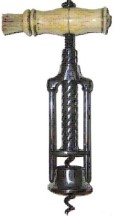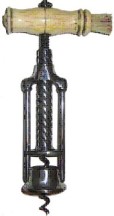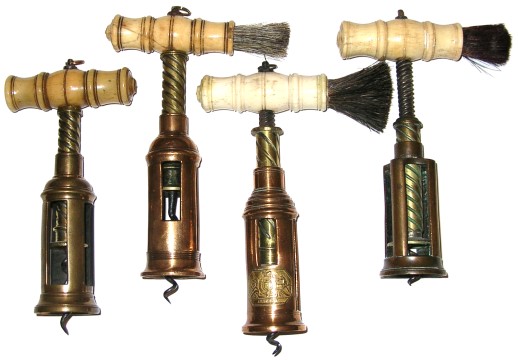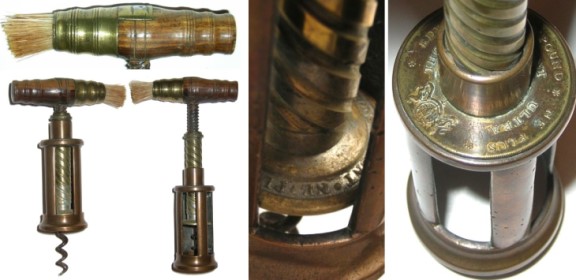 |
 The Virtual Corkscrew Museum's Weekly Newspaper |
 |
 |
 The Virtual Corkscrew Museum's Weekly Newspaper |
 |
|
Sunday, May 18, 2008 |
Number 517 |
Sir Edward Thomason
British Patent No. 2,617, May 7, 1802
On May 7, 1802 Edward Thomason of Birmingham was granted British Patent Number 2,617 for his " New Invented Material Article in the Making of Cork-Screws". The first drawing in the patent depicted an open frame corkscrew and included the term Ne Plus Ultra which was his motto and is translated as "None Better". There are a number of variations of corkscrews derived from the patent as well as examples produced by a host of manufacturers who were licensed to make the "Thomason". Several examples will be found at the end of this article.
We know about his patent but what about the man himself? Here is the story of Thomason from the 1870 compilation Warwickshire Worthies by F. L. Colvile (submitted by Mavis Watney).
Warkwickshire Worthies
The father of this pleasant, chatty, spirited yet egotistical manufacturer of Birmingham, was himself in business in that town as a buckle manufacturer, where he carried on a thriving trade for above forty years. During this period, shoe-buckles were worn by all classes of society, and it will give an idea of the universal adoption of this article of dress, when it is stated that in Mr. Thomason's manufactory as many as one thousand pair of buckles were daily completed. His private dwelling-house was at the corner of Colmore Row and Church Street, where his sone Edward was born in 1769, and afterwards took up his residence.
At the age of sixteen Edward Thomason was articled to the famed Matthew Boulton of Soho. The extent of Boutlon's manufactory and the diversified machinery used for the furtherance of the manufacture of the numerous and varied articles made on his premises, excelled all others of a like description in Europe. This scientific school produced in your Thomason a versatility of taste for mechanism, and a turn for art and science. On the other hand, it seems to have given him an ambitious feeling, far beyond the means he possessed on coming of age to indulge in.
When twenty-one years of age, he began to manufacture on his own account; first establishing the trade of gilt and silver buttons, of the finest class; he then added to it the trade of gilt and gold jewellery; to those was annexed a department for the making of medals, tokens, and coins, of gold, silver bronze &c., as well as works in bronze, and fine cut glass, &c. Lastly, he subjoined a manufactory for silver and gold plate, and silver-mounted plated wares of the highest class of workmanship. These trades occupied sixty or seventy rooms, including several devoted to exhibition.
But the line of business in which Mr. Edward Thomason was specially engaged for forty years, was confined to the highest class in the metallic arts. In 1830 he completed the laborious work of sixty large medals on the Bible; in which the most prominent events in Sacred History our concisely told. The origin of these medals arose from the visit to Birmingham of a gentleman connected with the Austrian Court, and who hitherto had never heard of Birmingham. Mr. Thomason was forcibly struck with this circumstance, and determined to endeavour to make the town known to all Monarchs and Courts in the civilized world; - hence the manufacture of these medals at a great cost, which were forwarded to all the Sovereigns of Europe. The presents Mr. Thomason received in return, which in some case were most princely, are certainly blazoned forth too conspicuously in his autobiography [Sir Edward Thomason's Memoirs during Half a Century was published in 1845 by Longman, Brown, Green, and Longmans, London] (but in fairness, it should be explained, that this so-called autobiography was left unfinished by the author, on account of the failure of his health, and therefore he cannot be considered responsible for the whole of its contents; which indeed makes him appear vain of success, and more earnest in seeking honours than in promotion of the Arts and Manufactures).
Mr. Thomason, who, it should not be forgotten, copied the Warwick Vase, the size of the original, in metallic bronze, was knighted by our Sovereign, in 1832, as acknowledgment of his artistic merits; on which occasion James Bisset, a name well-known both in Birmingham and Leamington, addressed to him the following lines:
To my very old and highly-esteemed friend, Sir Edward Thomason, Knt -
Dear Sir:
I congratulate you on the honour
So lately conferr'd by our Monarch (the donor),
Who, judging most wisely where merit was due,
The badge of true Knighthood bestowed upon you,
And feeling as all other amateurs felt,
Rewards you with title, gilt spurs, sword, and belt;
I remember the time (fifty years since, when boys)
Your name at SOHO 'gan to make a great noise;
And when to the 'toy shop of Europe' you came,
Each season exalted a THOMASON'S fame.
As an Artist whose works o'er the globe have been whirl'd,
Your renown has extended all over the world!
No wonder HIS MAJESTY then thought it right
(High-talented Edward) to make you a KNIGHT!I am, Sir, Your very faithfully,
James Bisset, A Septuagenarian
Belle Vue Place, Leamington Spa, July 2, 1832
At the time of Sir Edward Thomason's connection with Birmingham, the Charter of Incorporation had not been granted, the highest governing dignitary being then the High Bailiff, an appointment conferred annually be election; to this office Sir Edward Thomason was once chosen in 1818.
Sir Edward filled during twenty years, and for eight foreign Governments, the appointment of Vice-consul for the town of Birmingham, which regularly introduced him to foreigners of the highest distinction. He was honoured with more than thirty orders of foreign knighthood, gold medals of merit, &c.
In 1844 he retired from business, and went to reside at Ludlow, from whence he removed to Bath, and afterwards to Warwick; where he died in his house in Jury Street, in 1849. He was interred in the family vault in St. Philip's Church, Birmingham.
A portrait of Sir Edward, three-quarters size, and seated, is affixed to his Autobiography.
The Corkscrews
Thomason open frame similar to the first drawing in the patent.
Thomason Variant with serpent handle. Marked THOMASON NE PLUS ULTRA on the coat of arms.
Two examples of the Thomason Variant - different insertion handles and extraction handles.
Variations of the Gothic Windows.
Variations of the grapes and vines.
Example with decorative workmanship on top of barrel.
Narrow Fluted Barrel with full markings on button.

Various three and one half and four window Thomasons

Well marked four window Thomason with extended brass brush ferrule
Modern Thomasons
The Vulcan (see June 10, 2007 for further details).
The Factory
From History, Topography and Directory of Warwickshire by W. West (Birmingham, 1830).
Products
From Birmingham and its Vicinity as a Manufacturing and Commercial District by William Hawkes Smith, (London and Birmingham, 1836),
Frank Ellis (March 31, 1948 - May 11, 2008)
The Corkscrew World has lost a very important remarkable member. We were deeply saddened to learn that Frank Ellis passed away last week. Frank was an avid collector of corkscrews and a fountain of corkscrew knowledge. After spending hundreds of hours reseaching British Registered Corkscrew Designs, his book (co-researched and authored with wife Barbara) was published in 2007. An announcement for Corkscrews: British Registered Designs can be found in August 13, 2007 issue. That issue also included an article by Frank on the "Corkette". A feature story on the Corkscrews of Paul Gladman by Frank appeared in the May 13, 2007 issue. In addition, Frank was a frequent contributor to The Quarterly Worme, the newsletter of the CCCC.
Barbara wrote:
"I am very sorry to let you know that Frank died late on Sunday 11th May. He thought he had a bad gastric ulcer, but on investigation he was diagnosed with cancer of the pancreas. This was confirmed on 17th April. Unfortunately the cancer was extremely aggressive and rapid growing, and had spread to his liver, and then in the last week or so to his stomach. He went into hospital on Wednesday, not being able to eat at all, and had a stent put in his duodenum on Friday, but his
kidneys were failing and he was put under sedation on Sunday morning and then slipped away quietly.
As you know he enjoyed life to the full and we had a super time in Alsace at the end of March with the CFTB*, with a 60th birthday dinner with a few friends.
This was followed by a birthday lunch in Luton on 20th April with relatives and more friends. He was still able to eat and drink and enjoy!
It has all happened so quickly, much faster than the consultant thought initially. But at least he didn't suffer. The funeral will be on Thursday 22nd May at 1.00 pm.
The CCCC, CFTB and ABCDE meetings were highlights in Frank's calendar. There was nothing he enjoyed more than meeting his collector friends and discussing, showing, buying and selling corkscrews and having a drink and meal together. Thank you for the pleasure you all gave him over the years.
He greatly enjoyed your friendship and company, shared corkscrew activities and the hours of agonising over Screwbase.
Frank has requested no flowers, but if anyone wishes to make a donation to Macmillan Nurses (who look after cancer patients), this can be done by cheque(GB pounds only), credit card over the phone or Western Union Bank Transfer (in GB pounds). This should be done via the funeral directors -
Luton & Dunstable Funeral Service
266 Leagrave Road
Luton LU3 1RB
England
Tel: 44 (0) 1582 493500Thanks for your friendship."
Frank was a member of the CCCC (Canadian Corkscrew Collectors Club) and a founder member of the ABCDE (Association of British Corkscrew Devotees and Enthusiasts).
*CFTB = Club Français du Tire-Bouchon
|
©2008 Don Bull, Editor |